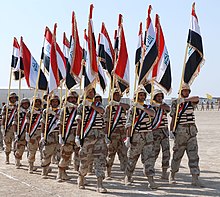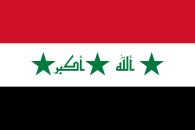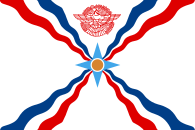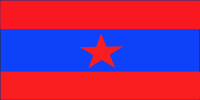Iraq flag
| Interim flag of Iraq | |
|---|---|
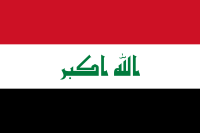 |
|
| Vexillological symbol : |
|
| Aspect ratio: | 2: 3 |
| Officially accepted: | January 22, 2008 |
The current national flag of Iraq is horizontally striped in red, white and black, in the white field it shows the inscription " Allāhu Akbar " in dark green Arabic script in Kufic font (الله اكبر, German: "God is greatest").
History of the Iraqi national flag
Mandate area
From 1919 to 1924, when Iraq was still the British Mandate of Mesopotamia , there are reports of several similar flags in the Pan-Arab colors . All designs had three horizontal stripes in black, white and green in different orders and a red triangle on the leech. Sometimes with the two white, seven-pointed stars in the red triangle of the later flag of the kingdom.
Flag of the Kingdom (1924-1958)
In 1921 Iraq was converted into a British protectorate in the Arab uprising and Faisal I was crowned king of Iraq as the first ruler. In 1932 the country gained independence as the Kingdom of Iraq . From 1924 the national flag showed three stripes (black, white and green) with a red trapezoid on the flag stick as a symbol of the Hashemite rebel leaders; in the trapezoid two white, seven-pointed stars symbolizing the Arabs and the Kurds. The flag of the Kingdom of Hejaz served as a model . This was also the flag of Transjordan from 1921 to 1928 and that of the Arab Federation between the kingdoms of Iraq and Jordan, founded in 1958 .
2: 3 ? Flag of the Kingdom of the Hejaz (approx. 1920-1926), Transjordan (1921-1928) and the Arab Federation (1958)

1: 2 ? Flag of Iraq 1921-1959

Flags of the Republic
In 1958 the short-lived flag of the Arab Federation was introduced, an amalgamation of the kingdoms of Iraq and Jordan. After the revolution of 1958 , a new flag was introduced (used from 1959 to 1963) that was vertically striped (black, white and green) as a symbol of pan-Arabism. In the center of the white stripe it showed the so-called sun of Mesopotamia , a yellow disk on a red eight-pointed sun. Yellow stood for the Kurds , red for the Assyrian Christians . It is still in use today in some Kurdish areas of Iraq.
After the fall of the Qasim government, the flag from 1963 first showed the basic pattern that is still valid today: three horizontal stripes of red-white-black with three green five-pointed stars in the white stripe. The stars refer to the year 1963, when Iraq, Egypt and Syria tried to found a new “ United Arab Republic ”.
The Takbīr Allahu Akbar was added in 1991, during the Second Gulf War , as part of Saddam Hussein's campaign to increasingly publicize himself as a devout Muslim. According to legend, the handwriting of “God is great” in the median is said to be from Saddam Hussein himself. Even if this has not been proven, this fact is assumed in Iraq, which is why the flag came under fire after the dictator was overthrown.
Flag dispute 2004 to 2008
After the fall of Saddam Hussein, the Iraqi government council presented a design from a competition for a new national flag in April 2004: a light blue crescent moon and a yellow stripe between two blue lines can be seen on a white background. White stands for peace and a new beginning in Iraq, the crescent symbolizes Islam. The blue stripes showed the two main rivers in the country, Euphrates and Tigris , and yellow represented the Kurdish population. The flag was designed by a brother of an Iraqi politician. The architect had lived in London for 40 years.
However, this flag design was criticized from many sides and therefore never introduced. The criticism related on the one hand to the unusual design and the unusual colors of the flag, which differ from the pan-Arab colors. The blue and white combination is perceived by many Iraqis as too similar to the flag of the unloved Israel . Also, the Islamic crescent was light blue rather than traditionally green or red. On the other hand, it was discussed whether the governing council, as an institution of an occupying power, even had the legitimation to introduce a new flag. Many felt the flag was a symbol of American Iraq .
The criticism led to the fact that the old flag was still used for the time being, but in a slightly modified form. The flag was introduced on June 28, 2004. It differs from the 1991 version only in the angular Kufic style .
In January 2008 a new flag proposal was presented to Parliament. The text Allahu Akbar should now be in yellow instead of green. The yellow color represented the Kurdish minority in the north of the country, which particularly protested against the old flag. She saw in her a symbol of the hated regime under Saddam Hussein. In the Kurdish areas, for example, a Kurdish flag was used instead of the Iraqi flag (see below) . Only in the Kurdish province of as-Sulaimaniya was the old flag from 1961 used without Saddam Hussein's handwriting. The 2004 interim solution was rejected by Kurdish leaders like Masud Barzani . The meaning of the three stars has also been changed. The three stars now symbolized peace, tolerance and justice. The colors of the flag should no longer stand for the Arab, but for the Islamic culture. However, contrary to initial reports, Barzani let it be known that the Kurds would never use a flag that still contained the three stars of the Baʿth party .
Another proposal replaced the three stars of the Baʿth party with an octagonal green star with a yellow disk in the center for the Kurds, similar to the sun of Mesopotamia , which was used in the national flag as early as 1959.
Finally, it was decided to remove the stars from the flag entirely. The lettering will still be in kufic, but now in dark green. The flag was initially only valid for one year, after which a new flag was discussed. The compromise was approved with 110 votes out of 165 in Parliament. 50 MPs voted against.
On July 15, 2008, the Iraqi government called for new proposals for a national flag to be submitted. Drafts could be submitted until the end of September. The decision on the new national flag of Iraq should be made by parliament at the end of the year, but this did not materialize. The final decision on a new national flag has not yet been made. The Iraqi flag, which has been in use since 2008, is regarded as a temporary solution; there is still no agreement on its final design.
7:10 ? Flag proposal from 2004

2: 3 ? Compromise solution between 2004 and 2008 with a modified font


2: 3 ? Short-lived flag proposal in January 2008

 ? Another proposal from January 2008
? Another proposal from January 2008
Minority flags
In the north, instead of the previous flag of Iraq , the Autonomous Region of Kurdistan uses the flag of Kurdistan with three horizontal stripes (red-white-green) and a golden sun with 21 rays in the center.
The National Congress of Turkomans (also Turkmens ) in Erbil wears a light blue flag with a white crescent moon that forms a circle with six small, five-pointed stars.
The Assyrian Christians live scattered in Iraq, as well as in Iran , Syria and Lebanon . They were already represented in the Iraqi national flag from 1959. The Assyrian flag was designed by the Assyrian Universal Alliance in 1968. It has its origin in the representation of the Assyrian sun god Shamash, in which the sun disk is on an altar. The golden circle in the middle represents the sun, which with its flames creates heat and light to sustain the living beings of the earth. The star that surrounds the sun symbolizes the land, the light blue color symbolizes serenity. The undulating stripes represent the three main rivers of the Assyrian homeland: the Tigris, the Euphrates and the great Zab . The dark blue stripes represent the Euphrates, whose Assyrian name means “Abundance”. The red stripes stand for courage, glory and pride, they represent the Tigris. The white lines between these two great rivers represent the great Zab, the white color symbolizes peace. Some interpret the red, white and blue stripes as the roads that will lead the scattered Assyrians back to their ancestral homeland. Above the Assyrian flag, the god of the Assyrians "Assur" from pre-Christian times can be seen.
2: 3 The flag of the Assyrians
2: 3 The flag of the Turkomans
Iraq political flags
The Baʿth Party , once ruling Iraq, used the flag of the Kingdom of the Hejaz in the pan-Arab colors of white, red, green and black. It is identical to the flag of Palestine and the flag of the former Arab Federation .
The Iraqi Democratic Union uses a variant of the national flag from 1959. Here the star is five-pointed.
The Turkmen Front of Iraq ( Iraq Turkmen Cephesi ) uses a light blue flag with two white horizontal stripes, a white crescent moon, and a white star. The colors are derived from the flag of the Turkomans.
The Democratic Party of Kurdistan flies a yellow flag with a red disc with the yellow letters “PdK” inside. The yellow color has been used as a party color since 1946. The designer of the flag was Hussain Haider .
1: 2 Kurdish Freedom Party ( Rizgari )
See also
Web links
- Flags of the World - Iraq
- Tagesschau report from February 5, 2008 on the new flag (tagesschau.de archive)
Individual evidence
- ↑ Radio Netherlands, January 15, 2008, Iraq's new flag half satisfies everyone ( Memento of the original from January 18, 2008 in the Internet Archive ) Info: The archive link was inserted automatically and has not yet been checked. Please check the original and archive link according to the instructions and then remove this notice.
- ↑ Aswat Aliraq, January 20, 2008 Parliament to vote on changing flag after four days ( Memento of 4 March 2008 at the Internet Archive )
- ^ NPR, January 12, 2008, Iraq to Restore Former Baath Party Followers
- ↑ ( Page no longer available , search in web archives ) Official website of the Parliament of Iraq (Arabic)
- ^ BBC, January 22, 2008, Iraq parliament approves new flag
- ↑ Iraq announces competition to design new national flag. ( Memento from January 21, 2013 in the web archive archive.today ) on: CW56. July 15, 2008.
- ^ Flags of the World - Flag of Turkoman National Congress
- ↑ Flags of the World - Assyria ( Memento from April 8, 2014 in the web archive archive.today )
- ^ Flags of the World - Iraqi Democratic Union
- ^ Flags of the World - Iraqi National Turkoman Party
- ^ Flags of the World - Kurdistan Democratic Party






